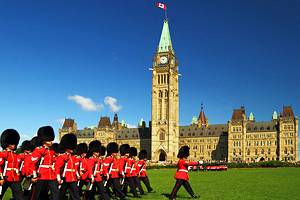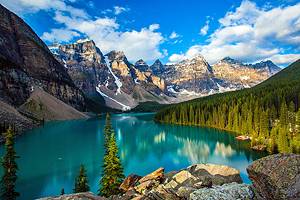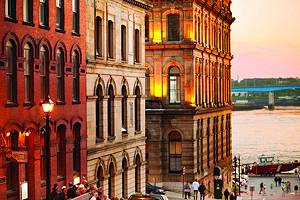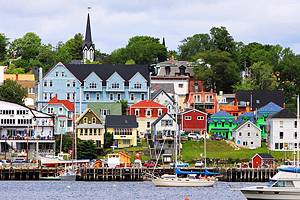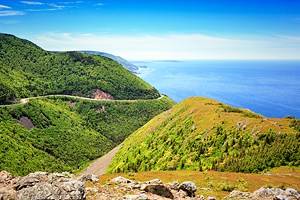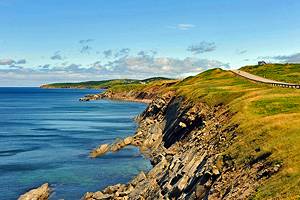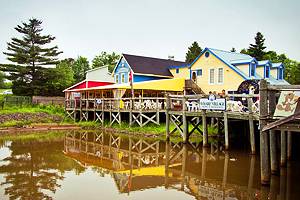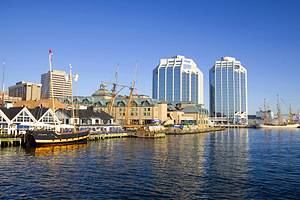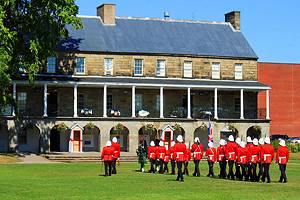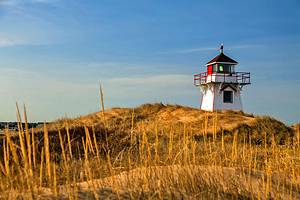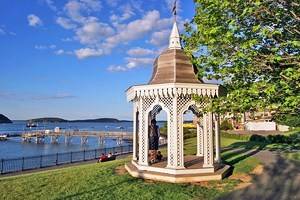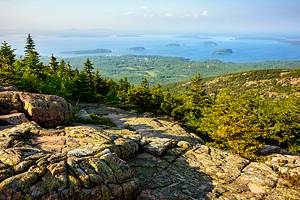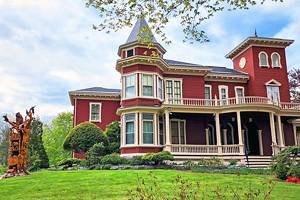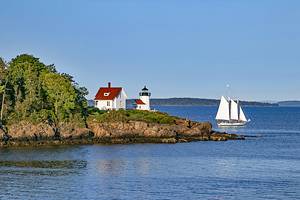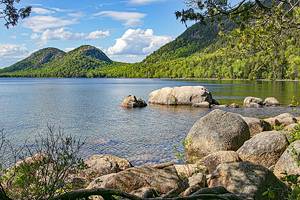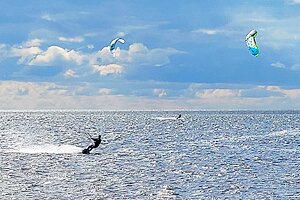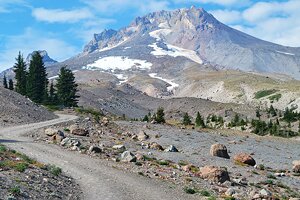13 Top-Rated Tourist Attractions on the Bay of Fundy
The Bay of Fundy, an arm of the Atlantic Ocean that separates New Brunswick and Nova Scotia in eastern Canada, has the world's highest tides. Twice each day, the waters rise and recede by a difference as great as 19 meters. The funnel-like shape of the bay and its length intensify the action of the tides, in many places forcing the waters to move so quickly that they become like rushing grindstones against the battered shore. The action of this tremendous volume of water rushing in and out of the bay has created many of the region's top tourist attractions, and a coastline filled with exciting things to do.
Visitors along New Brunswick's shore can explore sea caves at low tide and kayak around islands that a few hours later become giant flower-pot-shaped sea stacks rising out of a sandy beach. Scoured cliffs reveal eons of fossils; rivers and even waterfalls reverse to flow backward. The ever-changing water brings with it a largesse of marine life that makes this one of the world's prime places to go whale watching, with as many as 12 species found here in the summer.
Along with all these natural wonders, the Fundy shore offers superb seafood, scenic lighthouses, dramatic cliffs, islands, sandy beaches, and charming coastal villages filled with interesting places to go and things to see. Museums, galleries, and historic sites offer even more opportunities for sightseeing.
Discover the best things to do during your visit with our list of the top attractions on the Bay of Fundy.
See also: Where to Stay near the Bay of Fundy
- 1. Hopewell Rocks
- 2. Whale Watching
- 3. The Fundy Trail Parkway and St. Martins
- 4. Reversing Falls, Skywalk, and Stonehammer Geopark
- 5. Fundy National Park
- 6. Grand Manan Island
- 7. Roosevelt Campobello International Park and Campobello Island
- 8. St. Andrews-by-the-Sea
- 9. Riding the Shubenacadie River Tidal Bore
- 10. Joggins Fossil Cliffs
- 11. Petitcodiac River and Moncton Tidal Bore
- 12. Cape Enrage
- 13. Spotting Fundy Wildlife from the Deer Island Ferry
- Where to Stay near the Bay of Fundy for Sightseeing
- The Bay of Fundy (Saint John) - Climate Chart
1. Hopewell Rocks
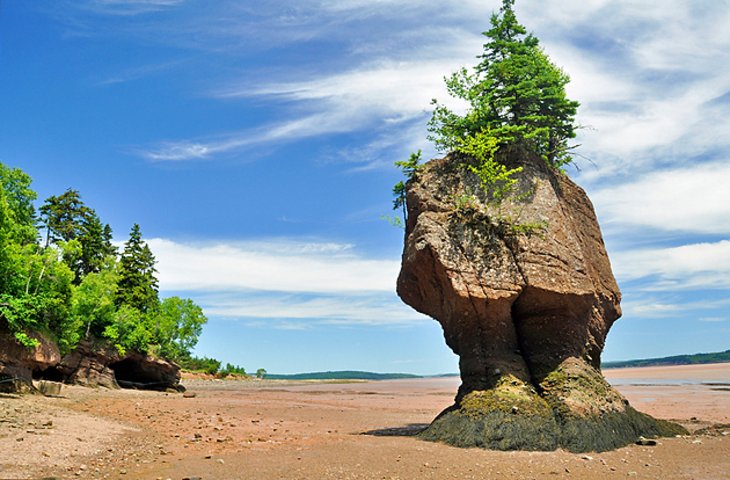
Of all the natural phenomena created by the tremendous surges of the Fundy tides, the most dramatic is at Hopewell Cape, where the sea has eroded towering cliffs, leaving great pillars of more resistant rocks standing separate along the shore. At high tide, these appear as tree-covered islands, topped by the vegetation that grew there when they were part of the cliffs. At low tide, these pillars stand alone, towering as much as 21 meters above the ocean floor, where you can walk among them.
The terra-cotta color of the rock and the narrower bases of the pillars makes them look like giant flower pots filled with trees, hence the nickname Flowerpot Rocks. At high tide, when water covers all but the tree-covered tops, you can view them from a platform; at low tide, you can descend the long flights of steps to the sea floor, where park rangers can answer questions about how they were formed and how they continue to erode. These rocks continue to change shape as the erosion continues; many families return year after year to compare the rocks with their shapes in past visits.
At high tide, the best way to experience these rocks is to kayak among them on a guided kayak excursion with Baymount Outdoor Adventures.
Address: 131 Discovery Road, Hopewell Cape, New Brunswick
Official site: http://www.thehopewellrocks.ca/
2. Whale Watching
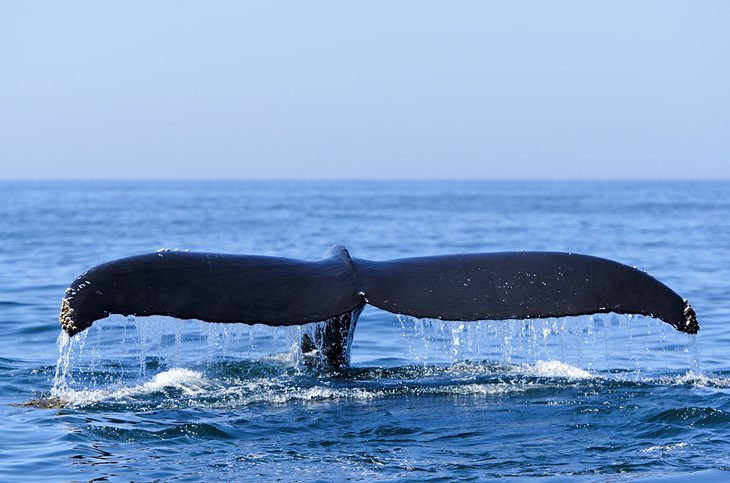
One of the world's top places for whale watching, the Bay of Fundy attracts as many as 12 species of whales and other marine animals in the summer. The rich supply of krill and fish swept in by the rushing tides makes the bay an ideal nursery and place to feed. Large schools of herring and mackerel provide food for whales, dolphins, seabirds, and seals.
The first to arrive in the spring are minke and finbacks, along with harbor porpoises, followed by humpback whales and white-sided dolphins in June. By midsummer, more species join them, including the rare North Atlantic Right Whale, and the occasional sperm and blue whale.
The season runs through October, with the highest rate of sightings in August. The chances of seeing not just a whale, but many whales and other marine life are excellent, and on the way, you'll cruise past lighthouses and islands that are nesting places for sea birds.
The two top places for whale watching cruises are St. Andrews in New Brunswick and across the bay at Brier Island, near the Annapolis Valley in Nova Scotia. In St. Andrews, you can choose from three distinct experiences: Island Quest Marine Whale and Wildlife Cruises are guided by certified marine naturalists, Fundy Tide Runners combines whale watching with the adrenaline rush of skimming across the sea by Zodiac, and Jolly Breeze Tall Ship is a fully rigged sailing ship with on-board activities that are especially popular for families with younger children.
The waters off Brier Island are important feeding areas for whales, dolphins, porpoises, seals, and a variety of seabirds, and Mariner Cruises offers whale watching and birding tours narrated by local naturalists. Cruises leave from Westport, on Brier Island, the most westerly location in Nova Scotia. Brier Island is also known for its variety of shore and seabirds, and in the fall is a stopover for hundreds of migrating warblers, shorebirds, and raptors.
3. The Fundy Trail Parkway and St. Martins
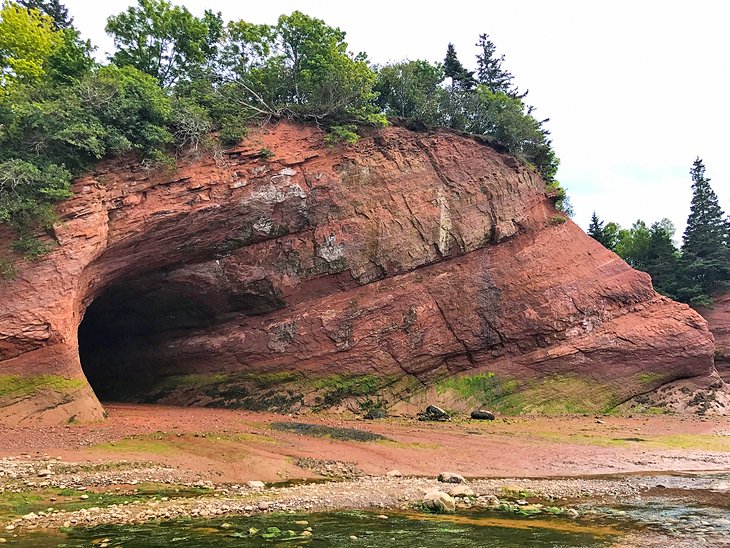
The former shipbuilding town of St. Martins is the gateway to the Fundy Trail Parkway, a scenic coastal drive that runs high above the coast, with cliff-top lookout points, hiking trails, picnic areas, and cove beaches. An 84-meter suspension foot bridge crosses the Big Salmon River at the site of a former logging community, where little remains today apart from the artifacts shown in the interpretive center and old lumbering equipment displayed at the Heritage Sawmill.
The Fundy Trail Parkway also crosses the river, climbing the steep headland and continuing along the cliff tops before descending to a long beach. Parking areas are at the scenic viewpoints, and on weekends a shuttle bus stops at these to return walkers to their cars.
St. Martins is worth a stop for its twin covered bridges and a former lighthouse where you can find visitor information. The red sandstone cliffs nearby are carved by the Fundy tides into massive sea caves, which you can explore from the beach below at low tide. As you pass the tiny harbor, notice the level of the boats moored at the wharves, then look again when you return from the parkway.
This is a good place to see the dramatic differences in the famous tides — if you arrive when the tide is out, the fishing boats sit in the mud of the ocean floor.
Official site: http://www.fundytrailparkway.com/
4. Reversing Falls, Skywalk, and Stonehammer Geopark
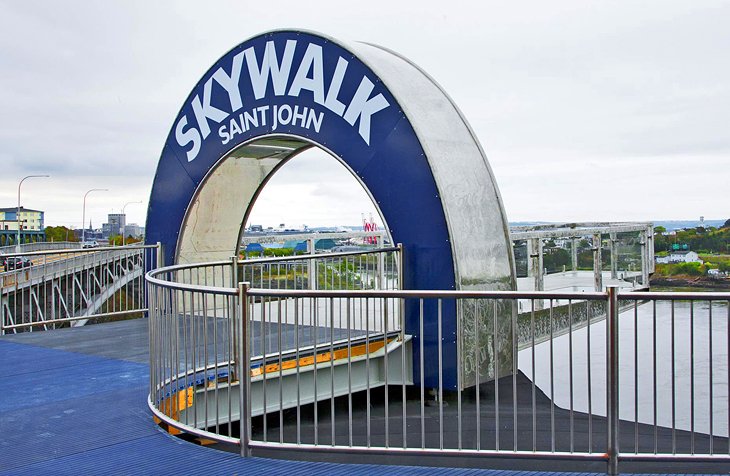
One of the best places to see the tremendous force of the Bay of Fundy tides in action is at the narrow gorge at the head of the harbor in Saint John. The rush of incoming tide forces it over a ridge of rock, creating a waterfall that flows upstream. The eight-meter difference between sea levels at high and low tide actually makes the Saint John River flow backwards here, stirring a seething mass of whirlpools as it meets the river's natural flow. Twelve hours later, when the tide ebbs, the river resumes its natural course, and the falls flow over the stone ridge in the other direction.
You can look directly down at the falls from the end of Reversing Falls Bridge, which crosses above the narrowest point of the gorge, and from the adjacent new Skywalk Saint John. This observation deck extends more than eight meters from the cliff, with glass floor panels that give a clear view of the falls and whirlpools 30 meters below. Interactive displays explain the tidal action and the geology of the cliffs that enclose it.
The intense rush of water is also visible from nearby Fallsview Park, where Stonehammer Geopark-the only UNESCO-listed global geopark in North America-has information panels on the tides and the geology of the cliffs. Get even closer and experience the tide's power on a boat ride into the gorge or a zipline high above the plunging waters.
Address: 200 Bridge Road, Saint John, New Brunswick
Official site: https://stonehammergeopark.com/
5. Fundy National Park
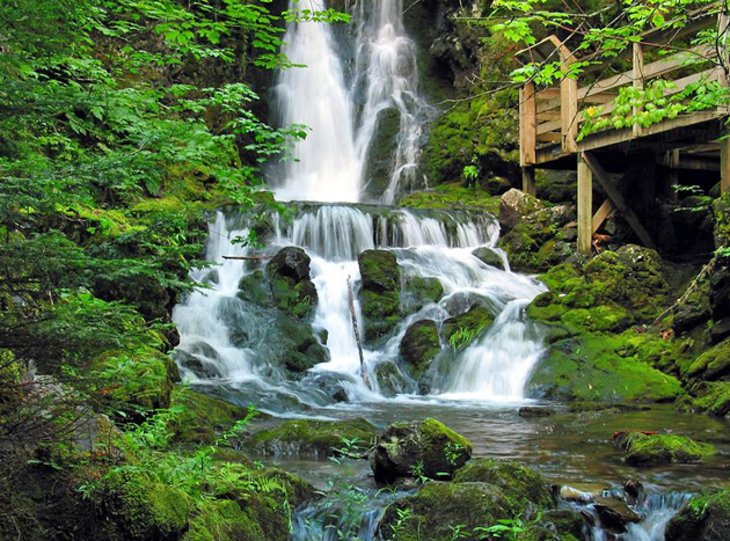
Protecting a stretch of undeveloped New Brunswick coastline, Bay of Fundy National Park is between the cities of Moncton and Saint John. The largely forested area is well equipped for year-round recreation, with campgrounds, hiking trails through the forests, coastal viewpoints, an outdoor swimming pool, boating, and a golf course.
Birders come here in the fall to witness the migratory species that feed in the nutrient-rich mudflats created by the tides. In the winter, 40 kilometers of the park's trails are groomed for cross-country skiing.
Alma, a small village inside the park boundaries, is a convenient center for lodging and dining, and for coastal sightseeing from a new perspective — you can join kayak tours here with Fresh Air Adventures.
Three of the most beautiful waterfalls in New Brunswick are near Alma: Dickson Falls; Laverty Falls; and Third Vault Falls, the tallest at 16 meters.
6. Grand Manan Island
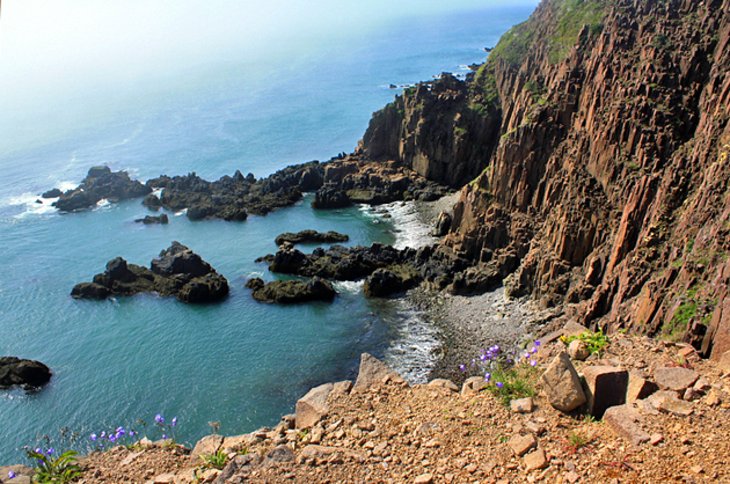
At the southwestern entrance to the Bay of Fundy, Grand Manan Island is reached by ferry from Blacks Harbour, not far from the US/Canada international border. Grand Manan is actually closer to Maine than to mainland Canada. Tiny fishing communities on its eastern shore are connected by a single road along its 35-kilometer length, and a few lanes lead across the island to its steep western shore.
Nature lovers come here to take whale watch tours and to spot some of the more than 240 bird species found here, including the Atlantic puffin. So sure are they to find whales in the waters off Grand Manan that trips with Sea Watch Tours are free if you do not.
Rockhounds visit the northwestern end of the island near Dark Harbour to find semi-precious stones such as amethysts, jasper, and agate, reminders of the island's volcanic past. Artists, writers, and other creative visitors come for the peace and quiet and the inspiration of the natural setting; you'll find their works in some of the low-key galleries here.
7. Roosevelt Campobello International Park and Campobello Island
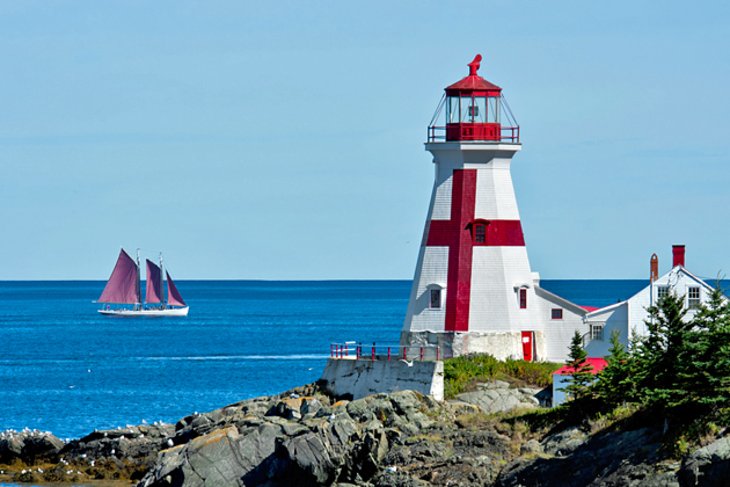
Although in the Canadian province of New Brunswick, Campobello Island is most easily reached by the international bridge from Lubec, Maine. You can also get here between mid-June and the end of September by ferries from mainland New Brunswick to Deer Island and on to Campobello.
The strong cross-border connections are reinforced by the International Park that preserves the summer home of President Franklin Roosevelt's family. The 34-room "cottage," where the Roosevelts summered with their children from 1905 until 1921, had been Franklin's childhood summer home, as well, and the guides throughout the house relate stories of the family and their time here.
One of the unique things to do at Roosevelt Campobello International Park is to join a "Tea with Eleanor" program, enjoying tea and cookies while staff members relate lively and personal stories about the former First Lady. You can also take self-guided walking tours using trail maps that highlight the island's geology, bogs, and wildflowers.
Herring Cove Provincial Park has more hiking trails, along with camping, golf, and beaches. At the northern tip of the island is the particularly photogenic East Quoddy Lighthouse.
Address: 459 Route 774, Welshpool, New Brunswick
Official site: http://www.fdr.net/
8. St. Andrews-by-the-Sea
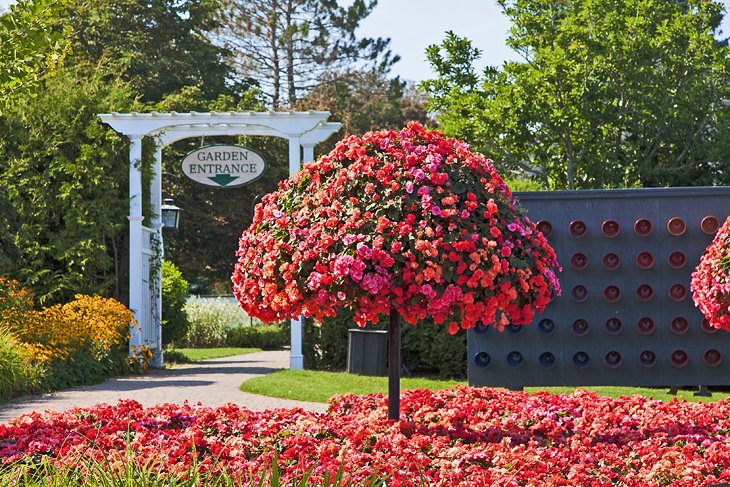
So close to the Canadian/US border that you can see the Maine shore from its attractive town center, St. Andrews (hardly anyone uses its longish full name) has been a vacation retreat for more than a century, as you can guess from some of the grand summer homes that crown the hilltop above the harbor.
One of these estates has become Kingsbrae Garden, one of Canada's premier horticultural attractions. Its themed gardens and floral displays include more than 50,000 perennials that benefit from the climate tempered by the Bay of Fundy. Another estate, the 50-room summer home of railway builder Sir William Van Horne, is now Ministers Island Historic Site.
Along with the shopping, restaurants, galleries, and whale watching, St. Andrews has several things to do for families, including the children's garden at Kingsbrae; a replica of a blockhouse from the War of 1812; and the Huntsman Marine Science Center, where you and your children can learn more about the Bay of Fundy through the kid-friendly interactive exhibits and aquarium. In special "backstage" tours, kids get to meet-and even feed-some sea animals not seen in the public exhibits.
Official site: https://standrewsbythesea.ca
9. Riding the Shubenacadie River Tidal Bore
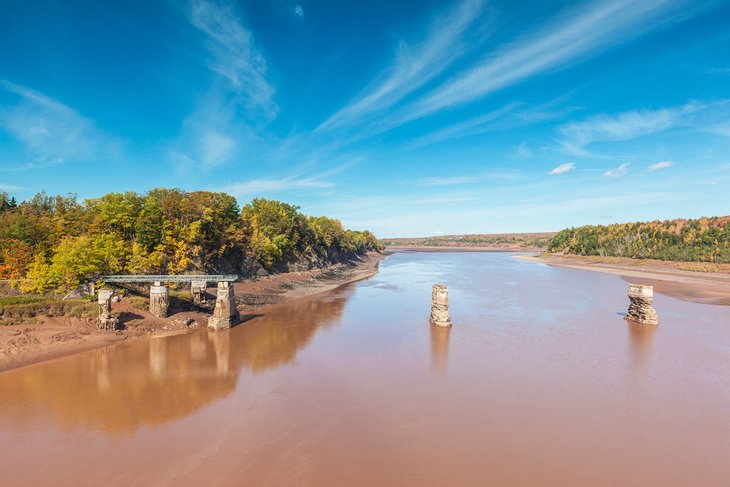
You can get up close and personal with the mighty Fundy tides as they rush into the Shubenacadie River, north of Halifax in central Nova Scotia. The concentrated power of the tidal flow forces it into the rivers that empty into the Cobequid Basin, a long arm of the Bay of Fundy that reaches eastward into the heart of Nova Scotia, reversing their flow twice daily.
In the most dramatic of these, it creates a single fast-moving wave-a wall of water that roars upstream along the Shubenacadie River. You can ride this crest with Shubenacadie River Adventure Tours or River Runners Tidal Bore Rafting for an unforgettable experience.
A good site for viewing the phenomenon is the Fundy Tidal Interpretive Centre, where you can learn more about how a tidal bore forms as muddy water rushes upriver. In other places along the Minas and Cobequid basins, you can walk at low tide on an ocean floor that six hours earlier was under several meters of sea water. A good place to observe the tides at work is at Cape Blomidon, a point of land that extends into the Minas Basin at its narrowest point.
Address: 9865 Highway 236, South Maitland, Nova Scotia
10. Joggins Fossil Cliffs
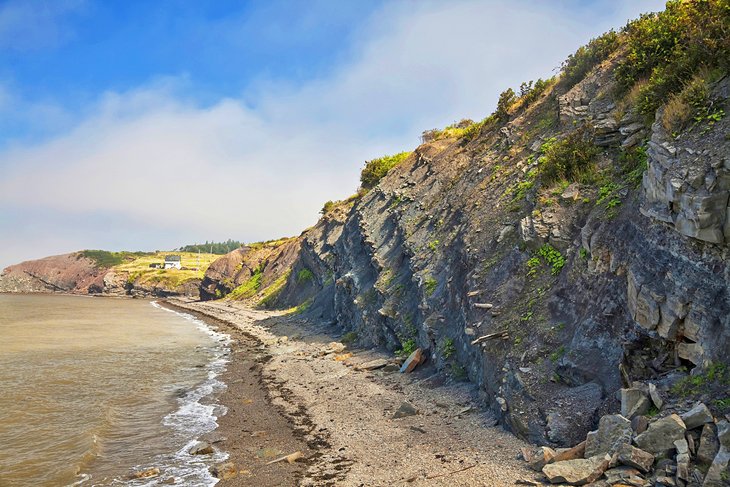
On the western coast of Nova Scotia, millennia of erosion by the Fundy tides have exposed 15 kilometers of coastal cliffs whose layers of rock reveal the world's most complete fossil record of life on earth 300 million years ago. During a time known as the Coal Age, lush forests and tropical vegetation covered Joggins and the entire area, producing huge quantities of organic matter that over millions of years created the coal deposits that give that era its name.
At the Joggins Fossil Cliffs UNESCO World Heritage Site, you can walk along the shore at low tide to see spectacular sandstone layers that record ancestors of the first dinosaurs. Constant tidal action continues to expose more, and breaks away more fossils that you can see on the beach. These layers of rock preserve examples of plants and animal life from that time that illuminated for the first time the emergence of animals from the water to live on land, an evolutionary milestone that was pivotal to understanding the origins of vertebrate life on land.
Overlooking the cliffs, the Joggins Fossil Centre is on the site of a former coal mine, and features a large collection of fossils and exhibits illustrating this geologic history, as well as the important scientific discoveries that were made here.
Address: 100 Main Street, Joggins, Nova Scotia
Official site: https://jogginsfossilcliffs.net
11. Petitcodiac River and Moncton Tidal Bore
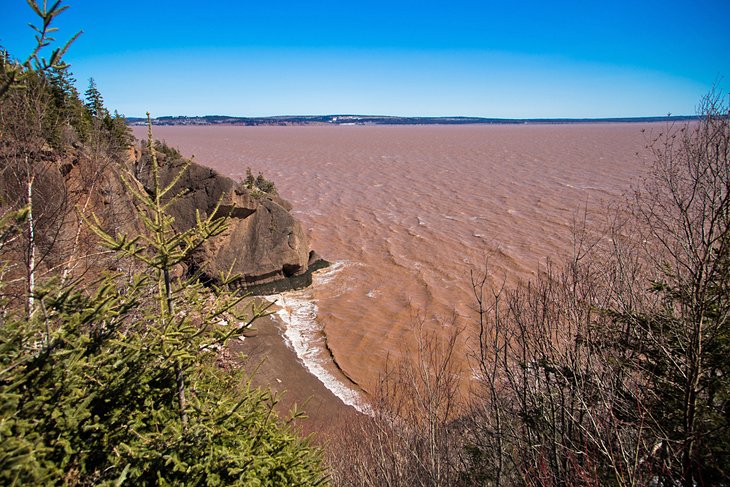
As the tides rush through the Bay of Fundy twice each day, the rapidly rising and falling sea water creates hundreds of acres of tidal mudflats, many of which reach far inland along rivers that are flooded by these daily incursions of sea water. In some cases it leaves the river channels nearly empty, as happens to the Petitcodiac River in Moncton.
At low tide, the Petitcodiac is a sea of rich brown mud, looking like a deeply carved bed of chocolate and earning it the nickname of the Chocolate River. In the winter, when ice freezes on the surface, the mud in places looks like layers of chocolate cake with frosting.
When the tide rushes in, it comes with such sudden force that it arrives in a meter-high wall of water, turning the narrow muddy riverbed into a 7.5-meter-deep river within an hour, and swelling its waters over nearby mudflats and salt marshes. Tidal Bore Park in downtown Moncton is the best place to catch this natural phenomenon, and a large clock here shows when to expect the next bore. Don't be late-it's over in an instant.
Address: Main Street, between King and Steadman Streets, Moncton, New Brunswick
12. Cape Enrage
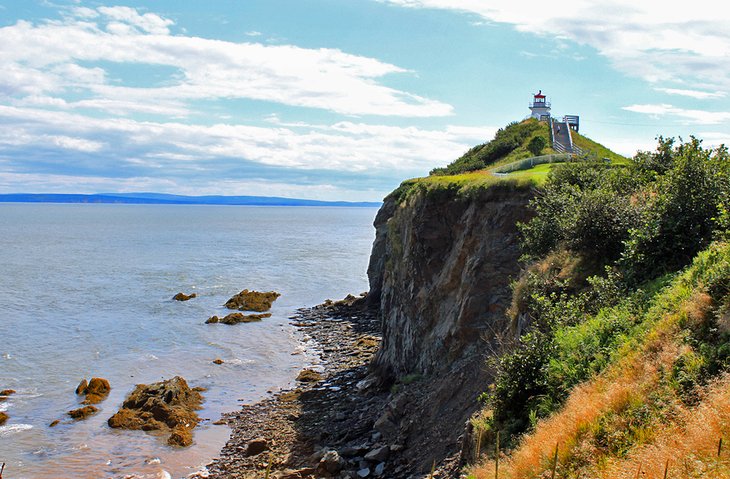
Extending far out into the Bay of Fundy from the New Brunswick shore, the high rugged cliffs of Cape Enrage overlook a large and dangerous reef that causes violent seas. In response to the number of shipwrecks here, in 1839 a lighthouse was built, and remains in operation today.
Along with housing the attractive little Cape House Restaurant and the Gallery at the Cape, the lighthouse is an outdoor activity center offering lots of things to do, including rock-climbing, rappelling, and kayaking, as well as a 600-foot zipline.
Viewing platforms overlook the towering cliffs, and below is a beach strewn with fossils from the soaring cliffs, revealing layers of 320-million-year-old sedimentary rock. Because of tides and falling rocks, this area is dangerous and should only be accessed with a guide from the center or with their advice.
Address: 650 Cape Enrage Road, Waterside, New Brunswick
Official site: http://www.capeenrage.ca/
13. Spotting Fundy Wildlife from the Deer Island Ferry
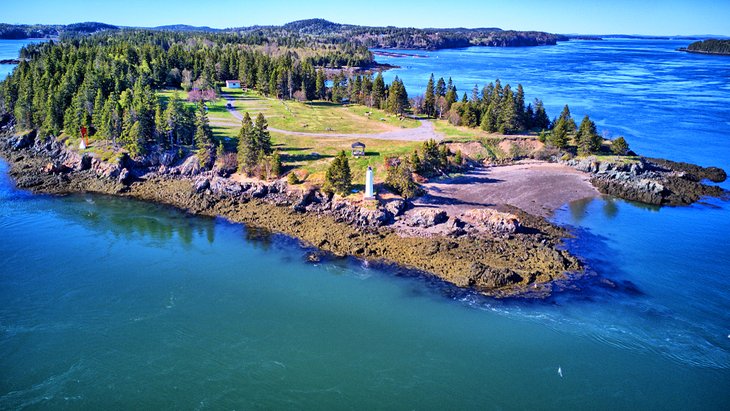
The ferry service between Campobello Island and the little harbor at L'Etete, New Brunswick, is not just a way to shorten the drive around the mainland, but an adventure of its own. The trip is in two parts, with Deer Island in the middle.
On the way, you may spot whales, dolphins, seals, eagles, or osprey, and just off the ferry landing at the southwestern shore of Deer Island, if the tide is right, you can see the largest tidal whirlpool in the Western Hemisphere. Known as the "Old Sow," the whirlpool is most visible within two hours of high tide as the waters from Maine's Passamaquoddy Bay exchange with those of the Bay of Fundy — a 20-foot differential.
Deer Island sits squarely on the 45th Parallel, halfway between the north Pole and the Equator, and a favorite thing to do here is to stop for lunch at the 45th Parallel Restaurant. Or bring a picnic to enjoy while waiting to see the whirlpool from the 40-acre park at Deer Island Point
Official site: www.eastcoastferriesltd.com
Where to Stay near the Bay of Fundy for Sightseeing
We recommend these convenient hotels close to the best places to visit on the Bay of Fundy:
Hotels in Fundy National Park and St. Martins:
- These places to stay give you a head start on visiting the coastal attractions between Saint John and Moncton. Parkland Village Inn has simple, comfortable rooms and a restaurant, next to the fishing wharf in the center of Alma, a small town inside Fundy National Park.
- Also moderately priced, Captains Inn is a cozy, homey B&B with a buffet breakfast.
- Tidal Watch Inn is a budget-friendly bed-and-breakfast in St. Martins, near the sea caves and with bay views.
Hotels in Moncton:
- Close to Hopewell Rocks and Cape Enrage, Moncton is an hour's drive from the Joggins Fossil Cliffs in Nova Scotia. These hotels are all close to the Tidal Bore viewing area in Moncton. A five-minute walk from the Tidal Bore and surrounded by downtown restaurants and shopping, Residence Inn by Marriott Moncton has spacious studio suites with fully equipped kitchens. There is an indoor pool and whirlpool.
- Rodd Moncton Hotel has riverside rooms overlooking the Tidal Bore, as well as an outdoor pool and terrace; free breakfast and parking are included at both hotels.
- For a budget option, the Midtown Motel & Suites has rooms with kitchenettes and a convenient location a few blocks from the central restaurant area. Parking is free.
Hotels in Saint John:
- About halfway along New Brunswick's Fundy coast, within easy reach of the national park and Fundy Trail Parkway, Saint John is home to Reversing Falls. Right at Market Square overlooking the harbor, Hilton Saint John is connected by indoor walkways to the New Brunswick Museum and the City Market, several blocks away. It has a pool, fitness center, and adjacent indoor parking.
- Outside of the city center, just off Route 1 and near the Irving Nature Park, Econo Lodge & Suites is a budget option that serves a free breakfast.
- For a more intimate boutique inn experience, Mahogany Manor Bed and Breakfast is located in a restored 1905 Victorian a couple of blocks from attractions and dining in the historic uptown.
Hotels in St. Andrews:
- At the mouth of the Bay of Fundy, St. Andrews is close to the ferries to Campobello and Grand Manan islands. The region's premier luxury hotel is The Algonquin Resort St. Andrews by-the-Sea, Autograph Collection, a beautifully restored historic hotel a short walk or complimentary shuttle ride from the main street shopping, restaurants, and galleries. It's close to Kingsbrae Garden, and the indoor and outdoor swimming pools and a multi-story waterslide make it popular with families.
- A good budget option is the charming little Picket Fence Motel, whose air-conditioned rooms and cozy cabins are about a 15-minute walk from the center of town. It's old-fashioned, but has all the modern comforts.
The Bay of Fundy (Saint John) - Climate Chart
| Average minimum and maximum temperatures for Saint John, NB in °C | |||||||||||
| J | F | M | A | M | J | J | A | S | O | N | D |
| -3 -14 | -2 -13 | 2 -8 | 8 -2 | 14 4 | 19 8 | 22 12 | 22 12 | 18 8 | 12 3 | 6 -2 | 0 -10 |
| PlanetWare.com | |||||||||||
| Average monthly precipitation totals for Saint John, NB in mm. | |||||||||||
| 130 | 102 | 109 | 109 | 125 | 104 | 104 | 104 | 112 | 122 | 147 | 168 |
| Average monthly snowfall totals for Saint John, NB in cm. | |||||||||||
| 72 | 56 | 48 | 23 | 2 | 0 | 0 | 0 | 0 | 2 | 15 | 64 |
| Average minimum and maximum temperatures for Saint John, NB in °F | |||||||||||
| J | F | M | A | M | J | J | A | S | O | N | D |
| 27 8 | 28 8 | 36 19 | 46 29 | 58 39 | 67 47 | 72 53 | 71 53 | 64 46 | 54 37 | 43 29 | 32 14 |
| PlanetWare.com | |||||||||||
| Average monthly precipitation totals for Saint John, NB in inches. | |||||||||||
| 5.1 | 4.0 | 4.3 | 4.3 | 4.9 | 4.1 | 4.1 | 4.1 | 4.4 | 4.8 | 5.8 | 6.6 |
| Average monthly snowfall totals for Saint John, NB in inches. | |||||||||||
| 28 | 22 | 19 | 9.1 | 0.9 | 0 | 0 | 0 | 0 | 0.9 | 5.9 | 25 |
More Related Articles on PlanetWare.com
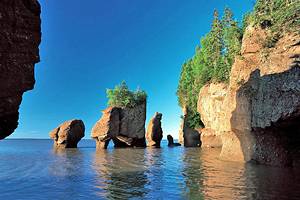
Places to Visit in New Brunswick: After you have seen natural wonders created by the Bay of Fundy, you may want to see more historic and other tourist attractions of New Brunswick. You can learn about its major cities on our pages about Saint John and Moncton, and its capital of Fredericton.
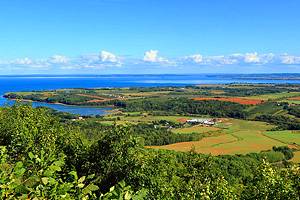
Where to Go in Nova Scotia: As you explore the opposite shore of the Bay of Fundy, you'll find many more attractions in Nova Scotia, including its lively capital city of Halifax. Be sure to refer to our lists of top attractions in the lovely Annapolis Valley and in historic Lunenburg and Mahoney Bay.


